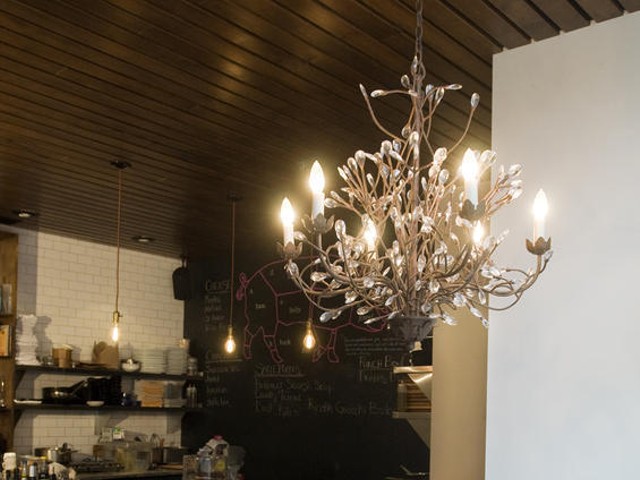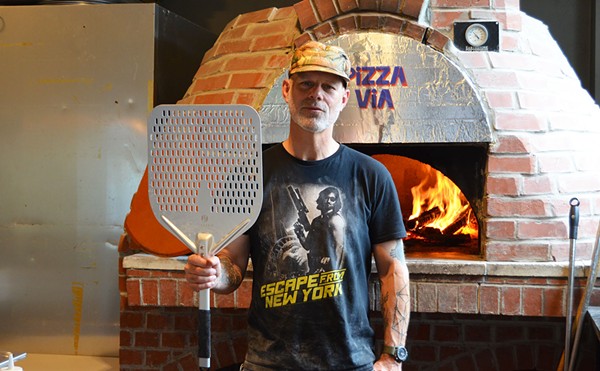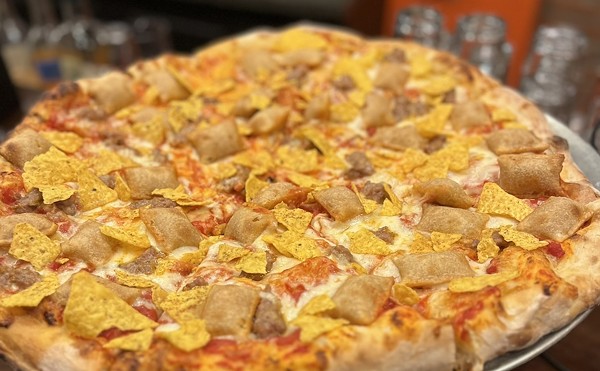"We need to reprint the menu," our server said by way of apology.
The new document will be difficult to fault. True to the restaurant's name, it will offer exactly what the average diner likely envisions when the word "bistro" appears: a decent steak and a braised lamb shank, plates of cheese and charcuterie, and bowls of mussels. Does the late-autumn menu include butternut-squash soup? But of course!
Mosaic Bistro Market opened in September, a Clayton sibling to Mosaic Modern Fusion in the loft district. Specifically, owner Ellen Schmitz is the sister of Mosaic owner Claus Schmitz; the restaurant also shares its executive chef, Ben Lester, with Claus' new upscale downtown steak house, Prime 1000. (The Schmitzes' brother, Frank, owns BARcelona, located just down the street from Mosaic Bistro Market.)
You enter directly from the sidewalk into the dining room, a space with a high ceiling and, when busy, a high volume to match. Seating crosses the line from cozy to close, with most tables crammed together along one wall. Opposite these tables are the bar and one large table for groups. The color scheme is white and orange, the décor minimal: Painted on the wall beside the open kitchen are a fork, knife and spoon; on another wall, a pattern made from the names of cities and countries. (New Zealand is spelled wrong.)
There is, in fact, a market inside Mosaic Bistro Market — or at least a wall (behind the large table) stocked with a few goods to purchase, including Illy coffee and Mosaic-branded ball caps. The market in its name doesn't refer to its latter-day connotation of local and/or seasonal produce, however; among the foods I encountered on my November visits were strawberries, asparagus and sweet peas.
The menu omits appetizers almost entirely. There are the aforementioned cheese and charcuterie plates and mussels, as well as a goat-cheese tart; otherwise, the first half of the menu is devoted to soups and salads. The charcuterie plate is conventional: Scattered among the crostini and various pickles are two small wedges of rich, funky pâté, mildly flavored pork rillettes and a few thin slices of smoked ham (it varies between German and Spanish) and fennel salami.
If you don't mind the out-of-season strawberries, the Bibb lettuce salad makes for a satisfying first course; the greens and fruit are tossed with goat cheese and candied walnuts in a white balsamic dressing. The "Bistro Caesar" salad skips the raw egg and anchovies but does include "chips" of finely chopped fried garlic. In small doses, these added a nice counterpoint to the greens, Parmesan cheese and lemon juice, but sprinkled over the entire salad they left a lingering acrid aftertaste.
The kitchen seems to have reserved its focus for the entrées, and for the most part, the results are evident on the plate. Each of the entrées I sampled (four of the seven that are available) were attractively plated, properly cooked and quite flavorful. Best of all were the scallops: four plump specimens beautifully browned top and bottom, tender all the way through their centers. The scallops, along with baby carrots and lardons, are served in an apple saba (a lightly sweet syrup made from apple must) alongside a bright green stripe of a sweet pea-rosemary purée. The saba and carrots amplified the scallops' natural sweetness, while the bacon added depth, and the purée a final accent. It would be an ideal dish for spring — though it's no less tasty now.
The "30-Hour" lamb chop is an impressive hunk of meat, fork tender and wonderfully unsubtle. It is no complaint to say this lamb tasted of nothing so much as lamb: meaty, with that distinct character somewhere between grassy and gamy. A roasted shallot jus provides another punch of rich flavor, though this benefits the lamb's accompaniments (baby carrots, broccolini and potatoes aligot) more than the meat itself. The potatoes — French mashed potatoes, impossibly creamy and further thickened with melted cheese — were lovely once I found them. Sadly, they were buried, both literally and in flavor, by the lamb.
The dry-aged strip steak arrives already sliced. In general I'm not partial to this presentation, as it doesn't allow for much char in any one bite. But in this case it did let me see with one glance that my steak had been cooked to order, medium-rare, purple-tinged red from edge to center. The steak was served in a sensible, unobtrusive cabernet reduction, with the unassailable combo of Brussels sprouts and bacon and two fat slices of a pungent potato gratin made with Roquefort.
When the rabbit was unavailable, I opted for the herb-roasted chicken breast. This is served over an "orzotto" of orzo with Gruyère, roasted mushrooms and asparagus tips. The dish includes a dash of white truffle oil, a passé trend that failed to mask the lackluster whole. The chicken was perfectly moist beneath its crisp (though not quite browned) skin, but any herb flavor was subtle — and white truffle oil is, of course, the enemy of subtlety — while the "orzotto" was like upscale cheesy rice.
The wine list is brief. Most bottles are priced under $60, though, as occurs at too many local establishments, when you're asked to pay $28 for a bottle of Wishing Tree shiraz the relationship between price and value is irredeemably skewed against the customer. Service is slow, though this seems a result of the restaurant being understaffed during busy dinner shifts rather than any fault of the servers themselves. One definite credit to the front-of-house staff: Our reservation was lost on one visit, but we were seated promptly even though the restaurant was packed and at least a couple of diners were waiting at the bar.
Even without the evidence of that crowd, I would say Mosaic Market Bistro is primed to succeed. It has the Mosaic "brand," and it gives us exactly what we expect from a bistro, nothing more, nothing less.





